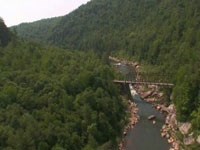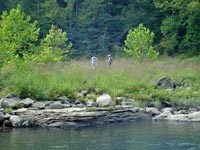
Chuck Summers The Big South Fork watershed covers approximately 1,123 square miles primarily in Fentress and Scott Counties, Tennessee and McCreary County Kentucky with smaller areas of Anderson, Campbell, Morgan and Pickett Counties, Tennessee. The Big South Fork protects the lower 14% of this area with the Big South Fork River draining the Cumberland Plateau northward, flowing into Lake Cumberland. A PDF file (51kb) delinating the watershed and the lands protected by Big South Fork in each county is available for viewing. Big South Fork waters are generally considered good quality, however, the rivers and streams which flow through the park are not without impacts nor safe from threats. Acid mine drainage, agricultural chemicals and excessive sediment from logging, substandard road construction, and other past and present ground disturbing activities significantly can affect both tributary streams and the Big South Fork River. Tennessee and Kentucky have designated their portions of the Big South Fork River as an Outstanding National Resource Waters. Kentucky has also recognized the section of the Big South Fork from the state line to Blue Heron mine as a Kentucky Wild River. Both Kentucky and Tennessee use stream classification systems through which they are able to protect surface water quality. Tennessee has classified all streams within the Big South Fork for primary contact recreation and fish and aquatic life. Kentucky classifies all Big South Fork streams for primary contact recreation and for either warm water or cold water aquatic habitat. Unfortunately a number of streams in the Big South Fork, in both states, do not meet these standards, primarily due to acid mine drainage and/or sedimentation. 
Famfive Productions Fly the Big South Fork River Gorge Come fly the gorge and look up at the rim.

Learn about long-term monitoring of freshwater mussels & cobble bar plant communities, conducted by the Appalachian Highlands Inventory & Monitoring Network at the Big South Fork National River & Recreation Area and the Obed Wild & Scenic River. For more information, please visit https://go.nps.gov/APHN. |
Last updated: November 25, 2015
